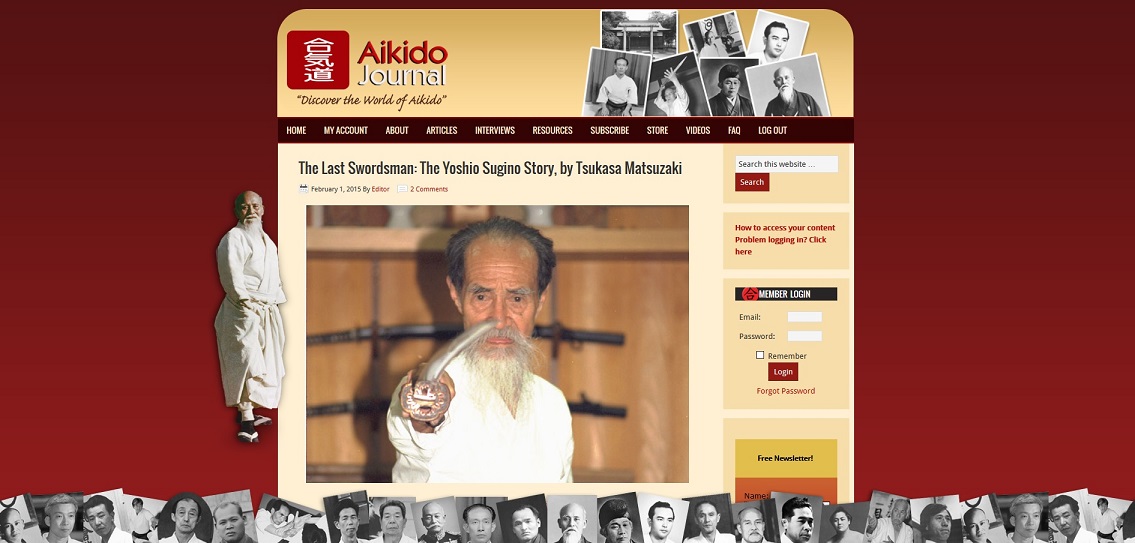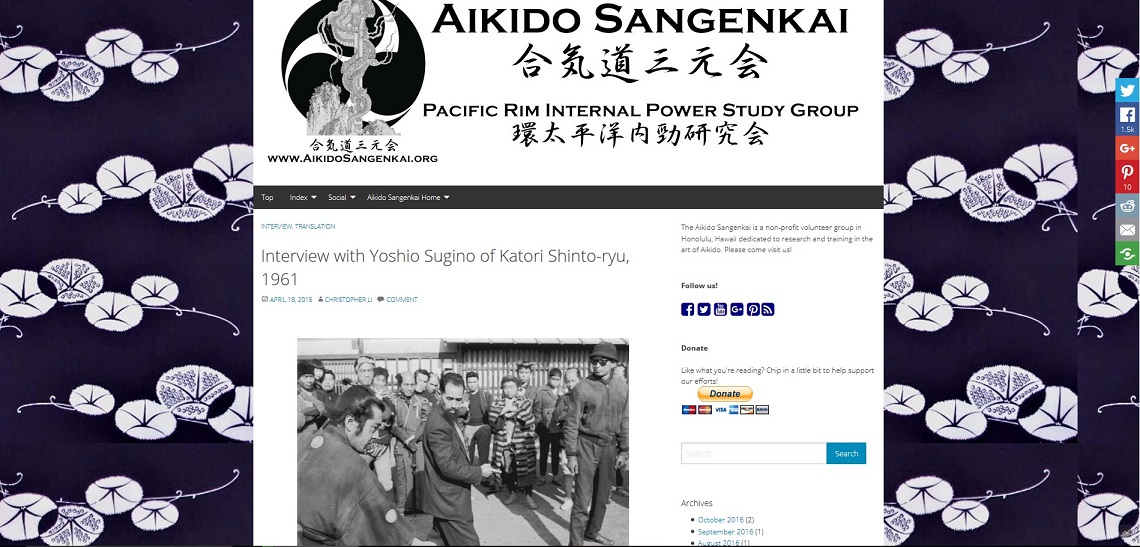While he was working in Japan, Mr. Tong studied Katori Shinto Ryu directly under the late Master Yoshio Sugino in Kawasaki-shi. He was one of his last direct pupils.
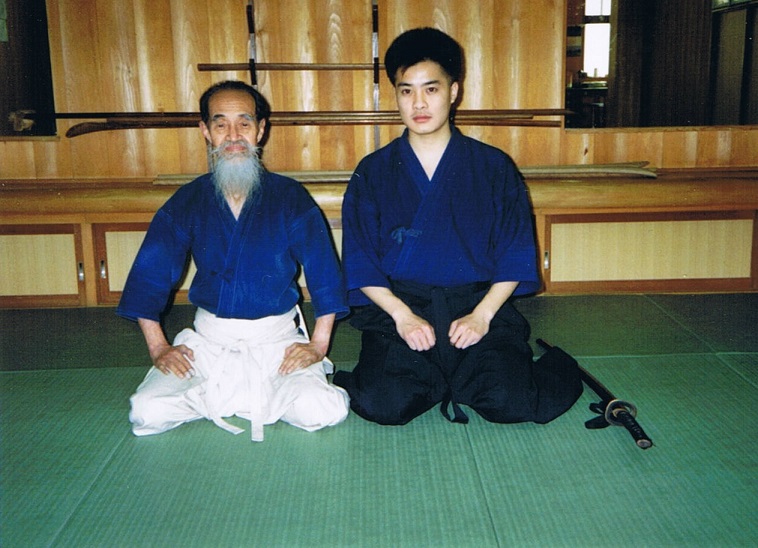
Sugino Yoshio Sensei with Mr. Tong (Kawasaki 1990)
——————————————————————————————————————————————–
“He has also provided martial arts instruction for many of Japan’s most popular historical movies, including Akira Kurosawa’s The Seven Samurai, adding dynamism and reality to what had been staid and poorly stylized fight-scene choreography. He has also appeared frequently in the media as a representative of the world of Japanese kobujutsu. In such ways he has contributed much toward introducing the truly wonderful aspects of Japanese martial arts to the public.”
Master Yoshio Sugino is best known for the excellence of his swordfight choreography for such monumental films as Akira Kurosawa’s ground-breaking Seven Samurai and Yojimbo as well as Hiroshi Inagaki’s epic masterpiece, Miyamoto Musashi (retitled Samurai Trilogy in North America and broken down into 3 segments: Samurai Part 1, Samurai Part 2, and Samurai Part 3).
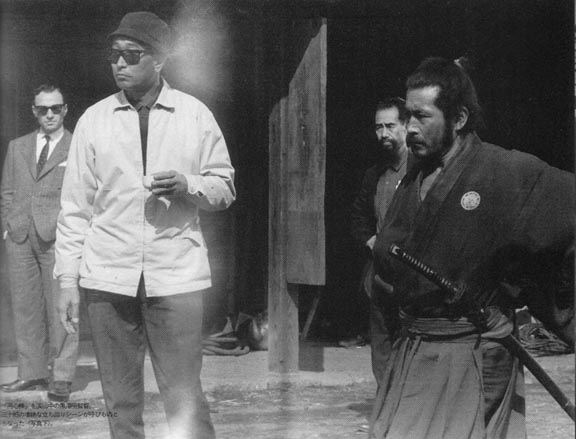
Master Yoshio Sugino (in the background) choreographing a fight scene on the set of Yojimbo with legendary director Akira Kurosawa (white jacket) and famed actor Toshiro Mifune . As a matter of fact, Mr. Mifune was a student of Katori Shinto Ryu under Master Sugino.
Aikido Journal published an excellent biography about Yoshio Sugino Sensei entitled “The Last Swordsman: The Yoshio Sugino Story by Tsukasa Matsuzaki”. This biography details the life of Yoshio Sugino Sensei from his youth through his training years to his later years. Of particular note is the fascinating look it gives us of his relationship with Director Akira Kurosawa and his work on Kurosawa’s movies. Please click on the photo below to read a part of this great story.
Or you can access both parts of this great interview here:
The Last Swordsman: The Yoshio Sugino Story, Part 1
The Last Swordsman: The Yoshio Sugino Story, Part 2
Here is an excerpt from this interview:
“On one occasion he was visited by Seiji Miyaguchi, who had initially refused his part in the film on the grounds that he did not feel up to playing the role of a strong, stalwart samurai. But Kurosawa talked him into it, telling him there was no need to worry since skillful camerawork could be relied upon to strengthen his image.
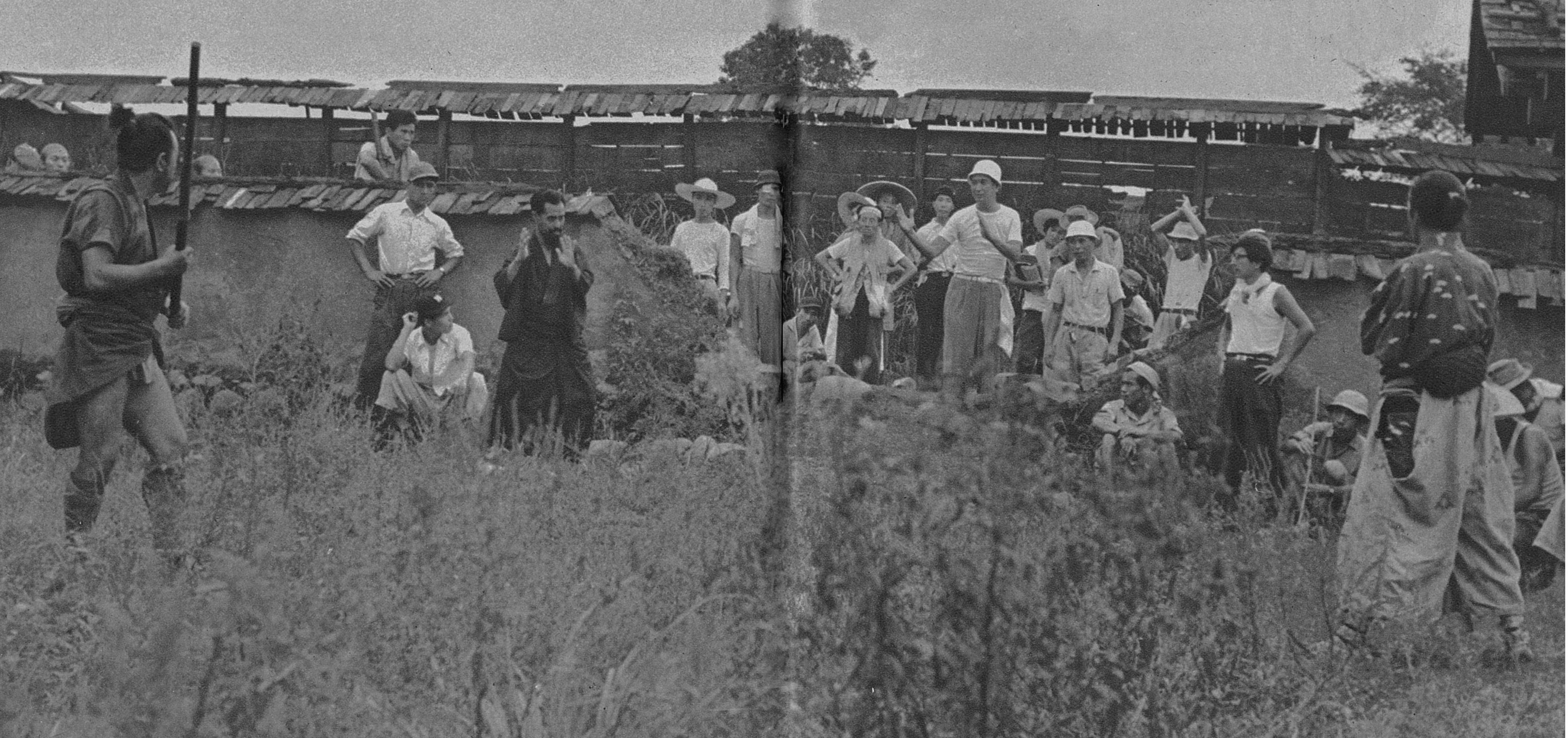
Sugino Sensei (in black kimono) on the set of Seven Samurai choreographing the pivotal fight scene between the braggart and Kyūzō, the stone-faced samurai, played by actor Seiji Miyaguchi (in kimono to the far right). Director Kurosawa (to the right) is dressed in white hat and white T-shirt.
Miyaguchi came to Sugino to ask for instruction for the scene in which his character Kyuzo — one of the most famous in Seven Samurai—makes his first appearance. Miyaguchi listened carefully to Sugino’s instructions and was soon managing beautifully despite his utter lack of experience. He spent two days practicing what he had learned and with a little extra coaching during the actual filming the scene became one of the most outstanding in Seven Samurai and in the history of the genre.”
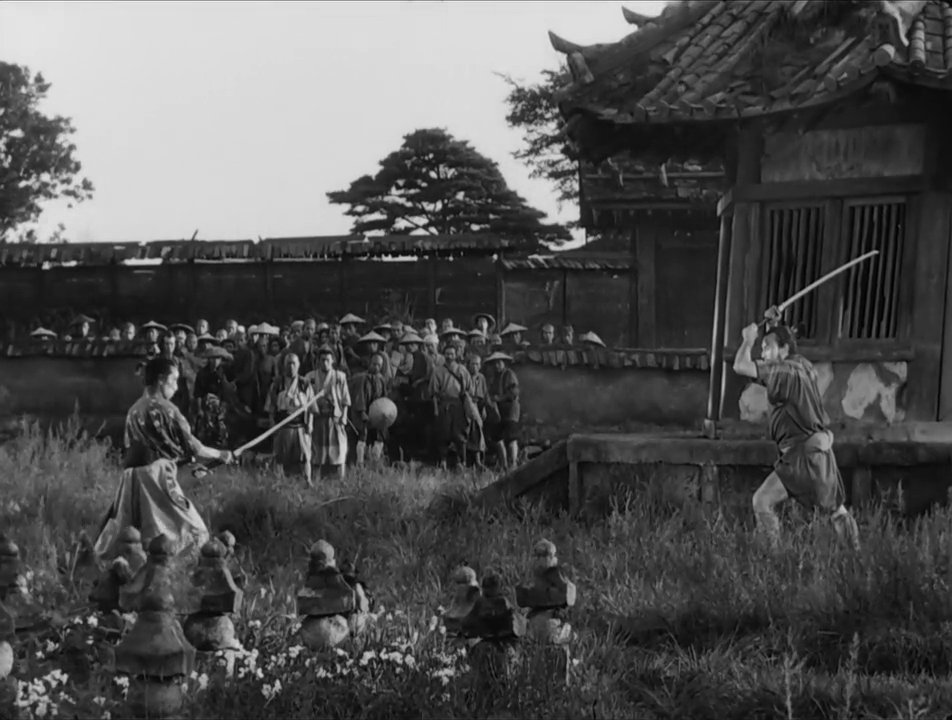
The finished product: One of the greatest swordfight scenes in Japanese film history. Notice the stances (kamae): On the left, seigan. On the right, jodan. Both are from the famous style of Katori Shinto Ryu.
——————————————————————————————————————————————–
Here is an excellent interview (reproduced and translated courtesy of Aikido Sangenkai) with Yoshio Sugino Sensei (杉野嘉男) and his son Shigeo Sugino (杉野茂男) that originally appeared in Japanese in “Kengo Retsuden-shu” (Biographies of Kendo Masters) number 67 Futabasha Publishers Ltd. (剣豪列伝集 67号 双葉社 1961年) in 1961. In this interview, Sugino Sensei discusses the history and philosophy of Katori Shinto Ryu:
“Morikawa: It came back to me with Yojimbo, but I heard that you have taught sword techniques for many movies and plays. Many of the actors were from the Kurosawa group, weren’t they?
Yoshio Sugino: Yes. (I taught for) Inagaki Sensei’s “Ganryujima” (巌流島), “Duel at Ichijoji Temple” (一乗寺決闘) and “Yagyu Secret Scrolls” (柳生武芸帳) as well.”
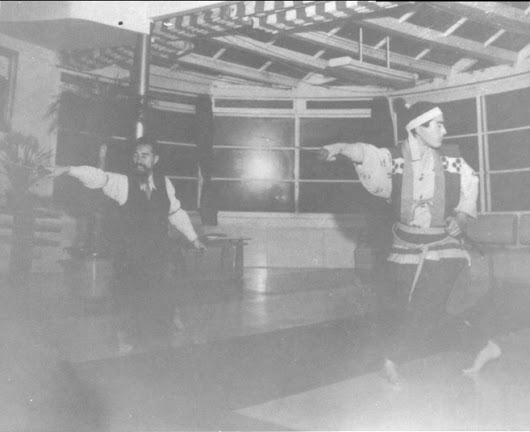
Sugino Sensei instructing actor Mifune Toshiro during the filming of Miyamoto Musashi: Duel at Ichijoji Temple (1955), a film directed by Director Hiroshi Inagaki. The technique shown here (jumonji and kiriharau) is from the 6th iaijutsu kata “Happoken” of Katori Shinto Ryu.
Highlights of Sugino Sensei’s illustrious career
He was the Swordfight Choreographer for: Seven Samurai (1954), Miyamoto Musashi (1954), Yagyû Bugeichô (1957), Hidden Fortress (1958), & Yojimbo (1961).
He designed some of the greatest and most iconic swordfighting scenes ever filmed in Japanese movie history.
• Studied under Jigoro Kano, the Founder of Judo (1918).
• Studied Katori Shinto Ryu from 1930.
• Studied under Morihei Ueshiba, the Founder of Aikido (1931).
• Representative of Katori Shinto Ryu at the founding of the Nihon Kobudo Shinkokai in 1935.
• Awarded 10th dan by Prince Naruhiko Higashikuni, 30th Prime Minister of Japan, in 1982.
——————————————————————————————————————————————–
Mr. Tong was very honoured to have studied at Sugino Dojo and to have participated in some of the key events in the history of the dojo.
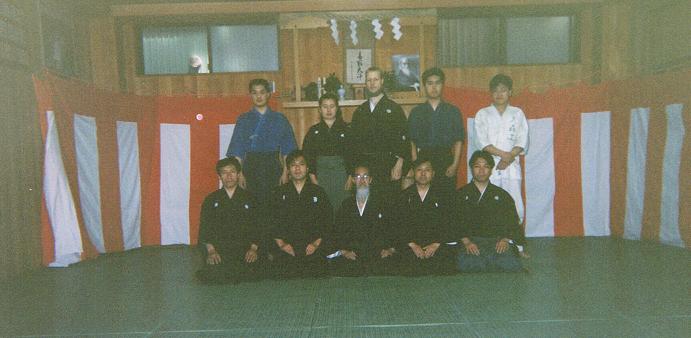
As part of the filming crew on the set for filming the only official video issued on the Sugino-style of Katori Shinto Ryu. (Mr. Tong is the first person from the left in the back row)
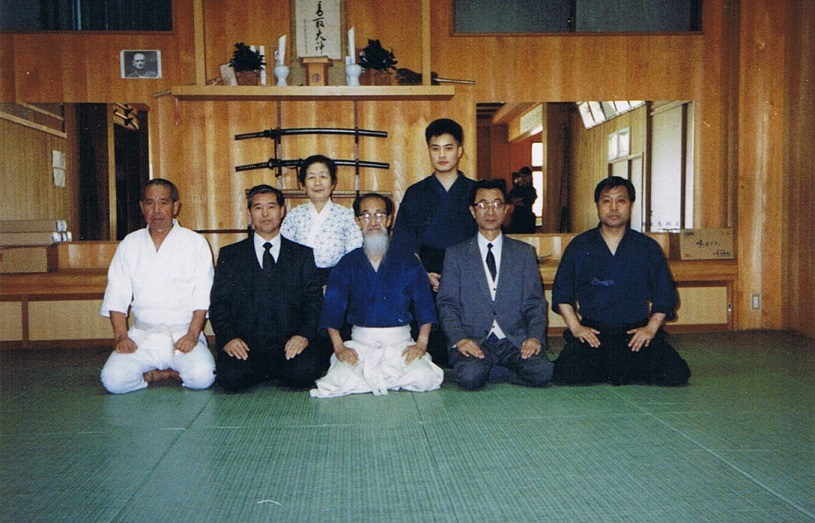
With the Sugino family and friends
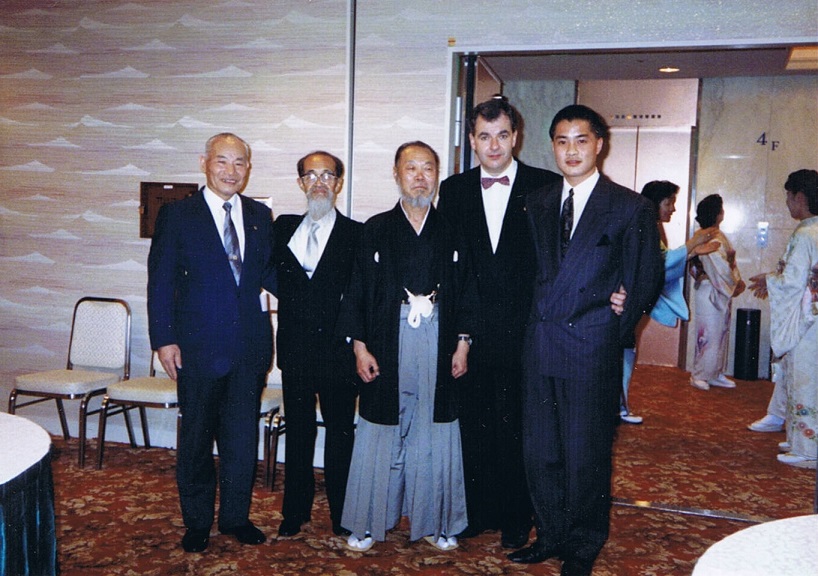
At an IFNB bonenkai with Master Yoshio Sugino and Sensei Patrick McCarthy (Tokyo 1991)
Mr. Tong has fond memories of his time with Sugino Yoshio Sensei and feels blessed to have been his student.
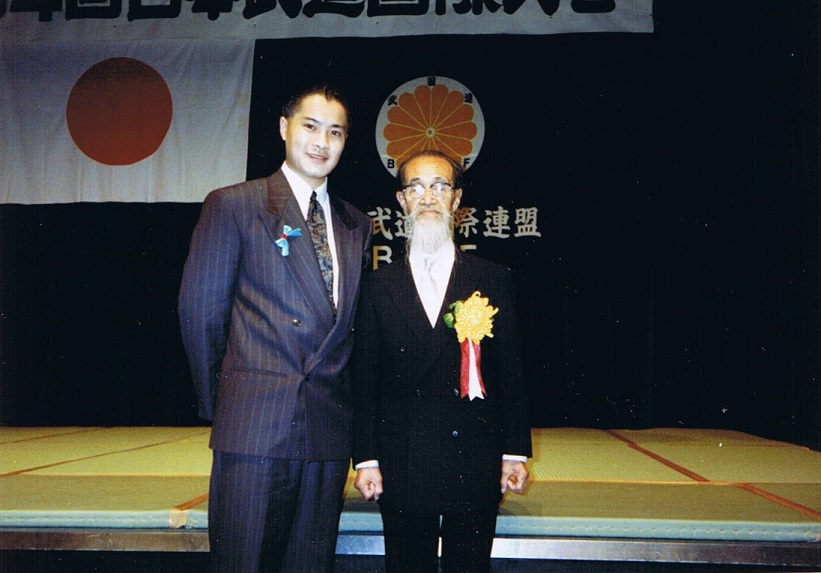
Mr. Tong with his teacher Sugino Yoshio Sensei at an IFNB demonstration (Kawasaki 1991)
Sugino Sensei passed away in 1998. He will be missed.

